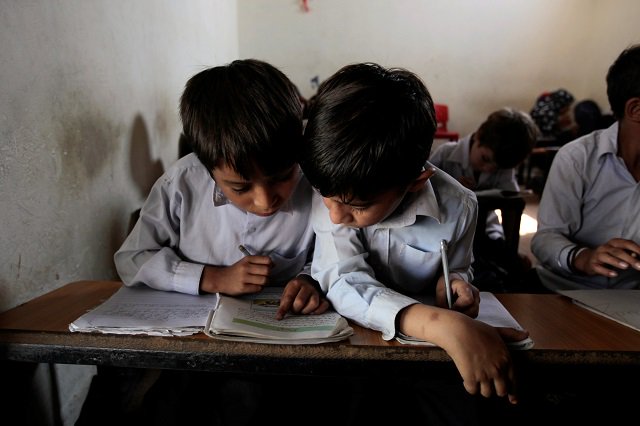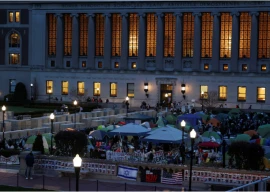
While this tectonic shift was credited to the increased focus of the government in providing basic facilities at schools across the province at an expenditure of Rs73.01 billion over the past five years, one component missed was the external factor of annual in school and van fees hikes in the private sector.
Muhammad Gul, who lives in Mardan, said that he shifted both of his children from a private school to the government school in the area hints to one of the primary motives for the move.
“I cannot afford the high fees and transport expenditures of my children,” Gul said, adding that this one of the primary motivators for him to shift his children to a government school.
Gul went on to praise the Pakistan Tehreek-e-Insaf (PTI) provincial government for its efforts to improve the standards of education in the public school sector apart from ensuring the provision of basic facilities at the schools.
Indeed, the provincial government from 2013 to 2018 worked to overhaul the education system in the province through a host of measures. Primary amongst them was a higher allocation of money for the sector and then to not only sustain it but to effectively double it over the course of its tenure.
The last Khyber-Pakhtunkhwa (K-P) government spent Rs9.86 billion in the fiscal year 2014-15, followed by an allocation of Rs13.54 billion in 2015-16, Rs19.81 billion in 2016-2017 and Rs29.8 billion in 2017-2018, for the provision of some 10,000 basic facilities at 24,336 of the 27,524 schools in the settled areas of the province.
The K-P Better Schools Programme report issued by the provincial education department showed that in the first month of 2018, the provincial government had invested some Rs30 billion in providing missing facilities to schools.
According to K-P Elementary and Secondary Education Annual Report for 2017-18, the money was spent to build some 7,682 new classrooms, 11,589 toilets, boundary walls in some 8,597 schools, providing water connections in 9,157 schools, setting up solar panels in 5,069 schools and providing electric power connections in 6,752 schools. The government also established play areas in some 4,715 schools.
Apart from working on a system to ensure attendance of teachers, some 57,000 new teachers were hired in the schools to fill vacant spots through the National Testing Service (NTS).
The report noted that of the 27,524 schools in the province, 17,064 schools can now boast of having all the required facilities.
Further, to monitor the usage and provision of facilities in schools, the provincial government had financially backed more than 25,000 Parent-Teacher Councils (PTCs) across the province.
Each council comprises of the principal of the respective school, parents of students and local government representatives. The council has been tasked with keeping a close eye on school infrastructure and other facilities.
These PTCs are also empowered to resolve school-related issues and keep a check on teachers during school visits.
K-P Elementary and Secondary Education Department (K-PESED) Director Farid Khattak said that over the last five years, the provincial government has provided basic facilities at almost all government schools across the province.
This has helped build parent confidence and trust in government schools. This, he claimed, was the main reason why parents had decided to pull around 150,000 children from private schools and move them to government schools.
Apart from the facilities listed in the annual report, Khattak stated that they were working on modernizing schools and in this regard, they had installed some 1,500 interactive whiteboards in high and higher secondary schools while nearly 1,500 computer labs were working in both, boys and girls schools, across the province.
Other incentives provided to students, Khattak said, include the provision of free textbooks and uniforms in some parts of the province. Some 200 poor families were also provided with transport to and from school for their girls.
Indeed, Gul said that if public schools provide quality education to their children with all the facilities, they will definitely not opt for other ‘costly’ options.
Educationist Muhammad Sajjad Khan, though, tempered the tall claims made by the provincial government of bringing revolutionary change in the education system, noting that the situation on the ground was not as rosy as painted in official documents. “The condition of schools in urban areas has improved,” he conceded, but added that “schools in remote areas continue to present a bleak picture.”
Noting that there were still a large number of schools which were without clean drinking water, boundary walls or toilets, he suggested focusing on providing basic facilities at schools in the rural and remote areas of the province.
All Primary Teachers Association (APTA) President Azizullah Khan did not agree with the claims made by the K-PESED chief, noting that there were other issues which had forced parents to shift their children to the public.
“The skyrocketing fees of private schools is the primary reason for parents to move their kids to government institutions,” Azizullah said.
The other reason, he claimed, was the distance that students need to cover to reach to their institutions. He added that private schools on average raise their fees by Rs200 to Rs400 every year. Add to this the annual increase in costs for associated facilities such as van fees, cost of books and uniforms, it becomes even more expensive to keep students in private schools.
Conceding that a large number of children had moved to government schools, Azizullah said that government schools still lack a number of facilities which are available in private schools.
“The measures taken by K-P government to improve the education sector in the province are commendable but officials should pay heed to the miseries of students and parents in remote areas where the provision of quality education remains a dream,” Azizullah said.
Published in The Express Tribune, January 21st, 2019.
































1713853507-0/MalalaHilary-(2)1713853507-0-270x192.webp)








COMMENTS
Comments are moderated and generally will be posted if they are on-topic and not abusive.
For more information, please see our Comments FAQ